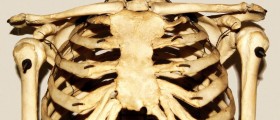
Marfan syndrome is a genetic disorder of the connective tissue. In the Marfan syndrome, the chemical structure of the connective tissue is abnormal. Connective tissue includes structures that support tendons, ligaments, blood vessel walls, cartilage, heart valves and many other structures. As a result of chemical abnormalities, these supportive tissues aren’t as stiff as they should be. People suffering from Marfan syndrome may have developmental and functional problems in various parts of the body. Most commonly, the affected parts of the body are heart, eyes, blood vessels and skeleton.
Symptoms of Marfan syndrome
People with the Marfan syndrome are often tall and thin with lender, tapering fingers, long arms and legs, flat feet, a high palate and crowded teeth, a breastbone that protrudes outward or dips inward, curvature of the spine, extreme nearsightedness and eye problems. Commonly, sufferers have heart problems. The syndrome may drastically vary from one affected person to another. Even within a single family, signs and symptoms may be completely different. In most of the cases, symptoms are worsening with age. Marfan syndrome may sometimes be extremely mild so that few symptoms exist and in severe cases, it may even cause life-threatening problems.
Causes of Marfan syndrome
Marfan syndrome is an autosomal dominant condition. This means that only one defective gene, from only one parent, is needed to pass the disease on. Each child of an affected parent has 50% of chance to inherit the defective gene. The syndrome is caused by mutations in the FBN1 gene on chromosome 15. The protein, produced with assistance of this gene, is essential for the appropriate formation of the extracellular matrix including the biogenesis and maintenance of elastic fibers. The extracellular matrix plays an essential role in a structural integrity of connective tissue, and serves as a reservoir for growth factor. Elastic fibers are found particularly abundant in the aorta, ligaments and the ciliary zonules of the eye.
Marfan syndrome affects equally men and women. People having a parent with the disorder are at greatest risk of developing the disease and passing it on to the future generations.
Treatment of Marfan syndrome
There is no cure for Marfan syndrome, but in the last couple of decades advanced treatments have provided many people with Marfan syndrome a chance to live near average life-span. Therapy is aimed on preventing the various complications of the disease, such as cardiovascular complications, eye complications, lung complications and complications of pregnancy. The syndrome is treated by focusing at each health issue as it arises, and, in particular, considering preventive medication.

















Your thoughts on this
Loading...